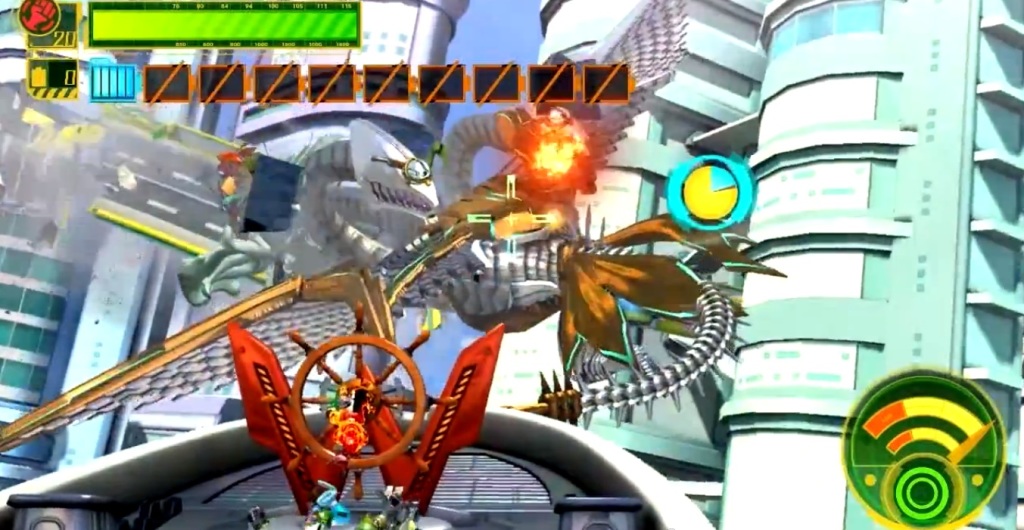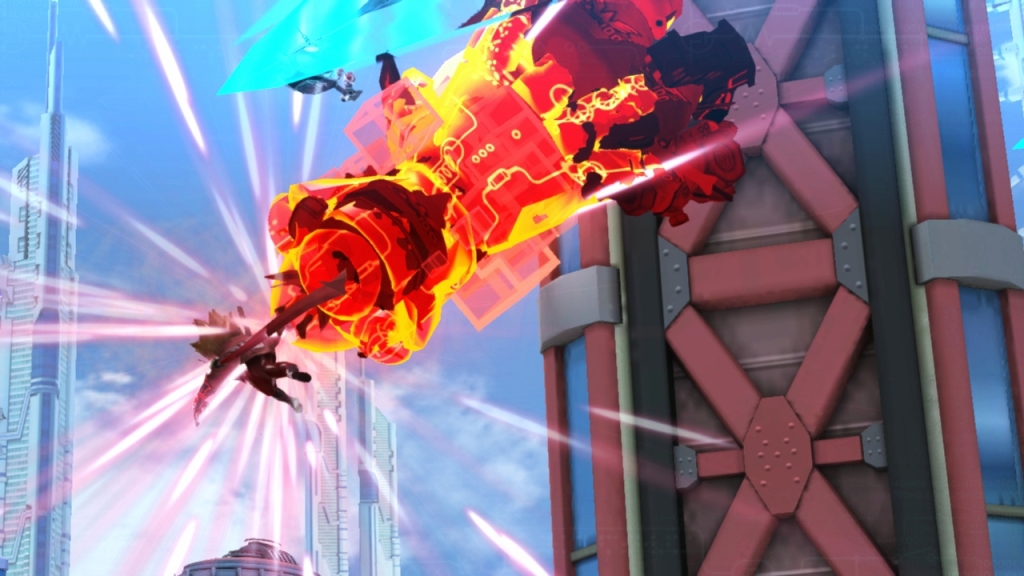Last updated on December 21, 2015
Part 2
Multi-tasking turns into a necessity, and The Wonderful 101 gives you the tools to fight multiple enemies at once. Drawing Unite Morphs with the X button instead of A will allow other characters in the group to attack independently of you for three seconds. You can draw up to four of these attacks at once (in addition to attacking by yourself), meaning you can pile on the damage and combo potential of your primary target or keep another one busy. Those kind of split-second decisions make every combat situation exciting. Each enemy only opens up their guard for a few seconds after stun, and you need to take advantage of those moments while making sure you don’t die in the process to other enemies or random projectiles. Given the number of weapons at your disposal, you’ll need to experiment with the most efficient means by which to kill your foes, and that process provides hours of enjoyable guesswork and guide efficiency. The scoring system plays perfectly into this model, encouraging the player to enlarge their combos, work fast, and take as little damage as possible. Sometimes you just need to run around until you find an opening, so take advantage of your run speed! In sum, it plays like a Hideki Kamiya game, but one that obviously takes a lot of risks that pay off wholly and utterly.
It helps that the levels space out these combat sequences into long, segmented experiences of exploration, puzzles, and random references to other video games that Hideki Kamiya loves. Honestly, the levels go on FOREVER, in a good way; they allow the designers to think about how they want to pace the various combat segments, and also when to add some variety to keep the player from boredom. “Absence makes the heart grow fonder”, as they say, and those quiet periods between combat segments add to their enjoyment. The Wonderful 101 experiments with GamePad-specific segments, mostly requiring you to use the second screen to control your characters into a tight room for the purpose of puzzles. None of these particularly amazed me (even the shooting sequence one just seems to be going through the motions), but they add unique elements and unexpected elements to the pacing of the LONG single-player levels. The puzzles separate from gimmicky use also implement the Unite Morphs in non-combat ways, allowing for new approaches to weapons and Unite Build that would otherwise make for constant fighting without respite. As well, you’ll want to explore levels for collectible that range from batteries (to increase your Unite Gauge – IMPORTANT) to other Wonderful Ones, most of which exist for the purpose of unlocking.
The boss battles, on the other hand, range the gamut from “taking advantage of The Wonderful 101’s unique combat systems” to “random implementation of different game style that ignores The Wonderful 101’s carefully crafted combat”. I love tributes to Space Harrier, Star Fox, The Legend of Zelda, Punch Out!, and many other Nintendo properties (apparently The Wonderful 101 started as a Nintendo tribute game, and remnants of that design remain), and they certainly play against against expectations, but being ranked for them seems a little problematic. Yes, you can succeed with practice, but they become annoyances when playing for score (as did the After Burner tribute in Bayonetta). Minor mistakes snowball into bigger ones, and constant restarting does not make these experiences fun as ranked experience. They still delight and amuse in the grand scheme of the game’s story and atmosphere, but they just don’t mesh well with the scoring system. They enhance the scale, if not the mechanics.

Probably the bigger issue lies with the “shooter” sequence (as in shmups) with an isometric perspective. Frankly, those segments don’t work well at all, as the spatial perception required to accurately dodge or absorb bullets is almost impossible to divine. Getting crushed by objects due to auto-scrolling happens more than a few times, and that’s a perfectly good way to piss off players looking for high ranks (those continues count against you!). Furthermore, Hard mode turns these sequences into bullet-hell shooters while your ship hitbox remains incredibly big; you can die in a matter of seconds if you’re not prepared. I hated this at first, but I realize that this demand for perfection forces creative use of Unite Morphs in an unorthodox setting (Unite Guts still works!). How you feel about thus amounts to expectations, and this variety will either endear itself to you or make you wish it would die in a fire.
Given the long list of complex ideas listed above, you would not think wrongly in assuming the game does not present you with something immediately accessible. The multiple difficulty levels only seek to emphasize this, as they change up enemy and boss patterns, requiring new approaches to old content. You’ll also takes reams of damage which will detrimentally impact your score, forcing you to play well and without mistakes. Of course, the Wonderful 101 does allow for a natural difficulty curve, but it demands your learn and retains more than ten different shapes of various uses in the heat of battles – not exactly easy stuff!
Of course, there’s a few issues that crop up due to the scale of the game: the camera. Yes, the camera’s not that great, although I’d hesitate to call it any worse than Metal Gear Rising: Revengeance‘s camera; at least it isn’t actively hampering your experience most of the time. The 100+ characters on screen demanded a new perspective, and in place of a traditional third person viewpoint, Platinum Games provides a strange isometric perspective. As a compromise, it allows them to retain the scale they desire. At the same time, the light platforming involved in some stages never feels quite right. Death isn’t an issue, as only combat deaths count, but losing a little health due to a bad camera made me question why they bothered in the first place. It’s also true that the camera does zoom in for dramatic effect on some sequences, but you can zoom out at most any time (simple taps of the L or R button alleviate your problems)…well, sometimes!

The camera will, at points, zoom in and out for no reason, and I’m not sure what causes it. I never found that the camera blindsided me with enemy attacks or cheap damage; enemies never appear without their presence made known via cutscene or otherwise, so the camera isn’t an issue if you analyze threats and prioritize accordingly. As well, GamePad segments turn buggy depending on the angle you hold the controller when entering them; the angle detection always felt a bit off, although L and R will adjust the camera even here. Just don’t pause; I found that pausing in these sequences would cause the GamePad camera to stop functioning. I imagine that’s a one-off glitch, but it’s still notable.
None of these problems really break the game, though; think of them as relatively minor annoyances on the way to pure gaming pleasure. If there’s one problem with the combat, I could say that Unite Bomb fixes many, too many problems in the game that you’d have. Unite Bomb’s the last standard weapon you get, and by then its usefulness becomes apparent. Anything touched by its blast radius slows down as if in a time warp, meaning that combo opportunities lengthen and you can really pile on the damage even on foes without a standard weakness. I found myself relying on it far too often for the later enemy types, turning many encounters into Unite Bomb spam. Thankfully, the challenge increase in Hard and 101% Hard renders this moot, as the enemy configurations won’t make Unite Bomb spam an optimal choice in nearly every situation.
That’s especially true of the Kahkoo-regahs, The Wonderful 101’s version of Secret Missions (along with actual Secret Missions that take some backtracking to find) – they require a level beyond your standard encounters, often requiring some trial and error or forethought to understand and complete, let alone medal! I should probably also mention Operation 101, the “ladder” test that presents the game’s greatest challenges, but I doubt most people will even get into that hour-long intense combat experience that probably highlights all the game’s strengths with none of its problems. Heck, the arenas of all such missions run at a smooth 60 FPS (contrast this to the slight slowdown of most missions, and you’ll see the difference) without clutter, so it all comes down to you and how you understand the game’s systems. Is that ever exciting!
